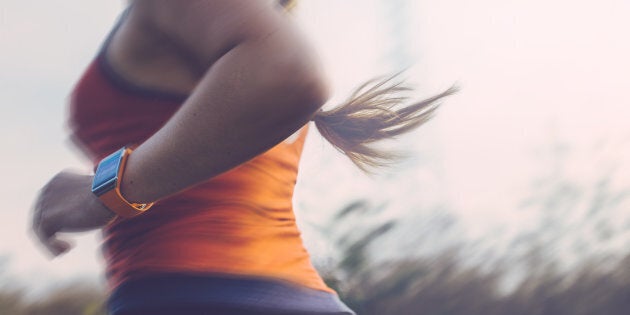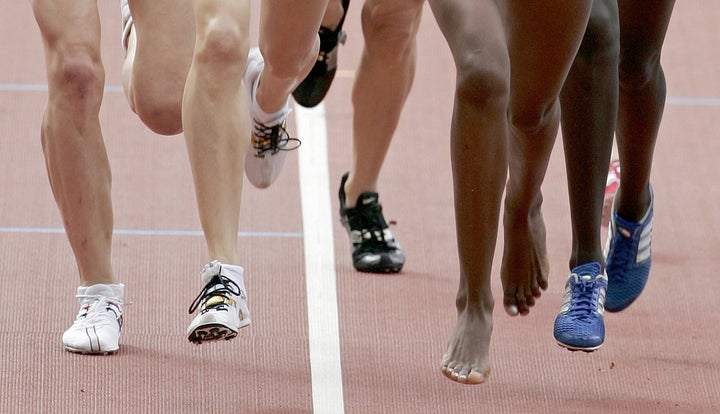

When it comes to race day, runners may have favorite moisture-wicking gear, a stopwatch and tunes to help get that coveted personal record.
But physicists say running at your top speed may actually be a lot simpler. It all comes down to the force of your foot striking the ground ― and that’s about it.
After studying the physics behind some of the world’s fastest runners, researchers came up with a new model they say could make anyone faster. It may help injured runners recover faster, too.
The researchers developed an equation that calculates two forces: The total force of the shin, ankle and foot striking the ground, and the total force of the rest of the body striking the ground. The method, which they detailed in an article published recently in the Journal of Experimental Biology, can predict how fast an athlete will run.
“We’ve known for quite some time that fast people are fast because they’re able to hit the ground harder in relation to how much they weigh,” explained the study’s co-author, Peter Weyand, director of the Locomotor Performance Laboratory at Southern Methodist University in Dallas.
But Weyand and his team were looking to better understand why it was that some people are able to hit the ground harder than others. The new equation makes the answer a lot clearer, with fewer measurements than previous models.
One needs to know three things in order to predict a runner’s speed: How much time a runner’s foot spends on the ground, how much time the runner is in the air, and how quickly the ankle is moving when the runner hits the ground.
These measurements reveal a lot that can help the runner go faster, identify an uneven stride that may lead to injury, or find ways to lessen the impact on joints, Weyand said.
Very basic physics lead to very accurate results.
The researchers collected data from 42 runners of varying abilities: Olympic sprinters, high school track athletes and ballet dancers who cross-train by running. They used high-speed motion cameras to measure participants’ gaits and force patterns.
Using basic physics, the researchers generated predictions about running speed based on the impact forces of each step.
They found that a simple two-mass model ― based on the force resulting from the impact of the lower leg (shin, ankle and foot) on the ground, and the force that lifts and supports the rest of the body ― was the equation that most accurately predicted speed, study co-author Laurence Ryan, a physicist and research engineer at SMU’s Locomotor Performance Laboratory, said in a statement. “This was true to within a millisecond, every single time. And we did it hundreds of times.”
This may help runners at all levels.
The new model can help runners at any performance level. But it’s likely to have the biggest impact on sprinters who already run with a very specific stride to get the most force out of each step.
“It’s actually a fairly unnatural action,” Craig Pickering, a British former sprinter who won bronze in the 100-meter relay team at the 2007 World Championships, previously told The Guardian. “As soon as the foot hits the floor you pick it up again in front of the body as quick as you can for the next step. Nothing happens behind the body.”
For distance runners and other non-sprinters, striking the ground harder could lead to joint injuries ― especially step after step for the thousands of strides you take on a run. Non-sprinters typically want to minimize the impact of their feet striking the ground.
But this new simplified model may help runners to be able to do that, too, Weyand explained, because it could help those runners better understand how to maximize the efficiency of their strides.
If you’re a weekend warrior trying to up your 10K game, you’ll still need someone familiar with these models to make tweaks to your stride that will actually increase your speed (or a software program to interpret the data for you) and a way of accurately measuring the forces you strike the ground with. For now, that means having access to a performance lab that can do those analyzes for you. Weyand said he suspects that in the future, video from a smartphone and a fairly simple software program may be able to do the same thing.
Eventually, for athletic training and some aspects of rehab, the research means runners will be able to get higher-quality feedback on their strides much less expensively than they can now.
Sarah DiGiulio is The Huffington Post’s sleep reporter. You can contact her at sarah.digiulio@huffingtonpost.com.